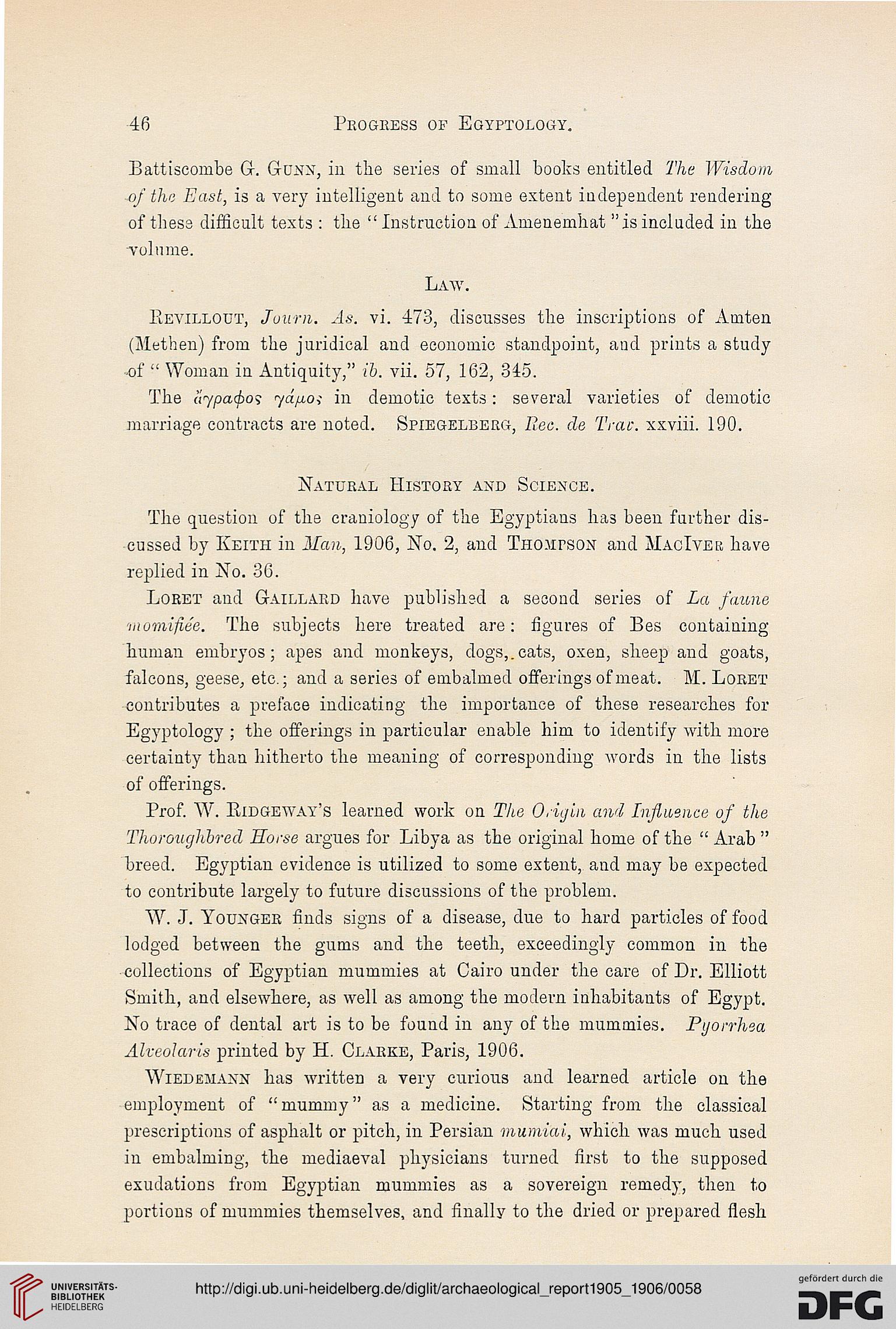46
Progress of Egyptology.
Battiseombe G-. Gonn, in the series of small books entitled The Wisdom
-of the East, is a very intelligent and to some extent independent rendering
of these difficult texts : the " Instruction of Amenemhat "is included in the
volume.
Law.
PiEVILLOUT, Journ. As. vi. 473, discusses the inscriptions of Amten
(Methen) from the juridical and economic standpoint, and prints a study
of " Woman in Antiquity," ib. vii. 57, 162, 345.
The I'typadioi yd/j.o; in demotic texts : several varieties of demotic
marriage contracts are noted. Spiegelberg, Ilea, de Trcu\ xxviii. 190.
Natural History and Science.
The question of the craniology of the Egyptians has been further dis-
cussed by Keith in Man, 1906, No. 2, and TuoJirsoN and MacIvee have
replied in No. 36.
Loret and Gaillard have published a second series of La fauna
momifiee. The subjects here treated are: figures of Bes containing
human embryos; apes and monkeys, dogs,.cats, oxen, sheep and goats,
falcons, geese, etc.; and a series of embalmed offerings of meat. M. Loret
contributes a preface indicating the importance of these researches for
Egyptology ; the offerings in particular enable him to identify with more
certainty than hitherto the meaning of corresponding words in the lists
of offerings.
Prof. W. KlDGEWAY's learned work on The Origin awl Influence of the
Thoroughbred Horse argues for Libya as the original home of the " Arab "
breed. Egyptian evidence is utilized to some extent, and may be expected
to contribute largely to future discussions of the problem.
W. J. Younger finds signs of a disease, due to hard particles of food
lodged between the gums and the teeth, exceedingly common in the
collections of Egyptian mummies at Cairo under the care of Dr. Elliott
Smith, and elsewhere, as well as among the modern inhabitants of Egypt.
No trace of dental art is to be found in any of the mummies. Pyorrhea
Alveolaris printed by H. Clarke, Paris, 1906.
Wiedemann has written a very curious and learned article on the
employment of "mummy" as a medicine. Starting from the classical
prescriptions of asphalt or pitch, in Persian mumiai, which was much used
in embalming, the mediaeval physicians turned first to the supposed
exudations from Egyptian mummies as a sovereign remedy, then to
portions of mummies themselves, and finally to the dried or prepared flesh
Progress of Egyptology.
Battiseombe G-. Gonn, in the series of small books entitled The Wisdom
-of the East, is a very intelligent and to some extent independent rendering
of these difficult texts : the " Instruction of Amenemhat "is included in the
volume.
Law.
PiEVILLOUT, Journ. As. vi. 473, discusses the inscriptions of Amten
(Methen) from the juridical and economic standpoint, and prints a study
of " Woman in Antiquity," ib. vii. 57, 162, 345.
The I'typadioi yd/j.o; in demotic texts : several varieties of demotic
marriage contracts are noted. Spiegelberg, Ilea, de Trcu\ xxviii. 190.
Natural History and Science.
The question of the craniology of the Egyptians has been further dis-
cussed by Keith in Man, 1906, No. 2, and TuoJirsoN and MacIvee have
replied in No. 36.
Loret and Gaillard have published a second series of La fauna
momifiee. The subjects here treated are: figures of Bes containing
human embryos; apes and monkeys, dogs,.cats, oxen, sheep and goats,
falcons, geese, etc.; and a series of embalmed offerings of meat. M. Loret
contributes a preface indicating the importance of these researches for
Egyptology ; the offerings in particular enable him to identify with more
certainty than hitherto the meaning of corresponding words in the lists
of offerings.
Prof. W. KlDGEWAY's learned work on The Origin awl Influence of the
Thoroughbred Horse argues for Libya as the original home of the " Arab "
breed. Egyptian evidence is utilized to some extent, and may be expected
to contribute largely to future discussions of the problem.
W. J. Younger finds signs of a disease, due to hard particles of food
lodged between the gums and the teeth, exceedingly common in the
collections of Egyptian mummies at Cairo under the care of Dr. Elliott
Smith, and elsewhere, as well as among the modern inhabitants of Egypt.
No trace of dental art is to be found in any of the mummies. Pyorrhea
Alveolaris printed by H. Clarke, Paris, 1906.
Wiedemann has written a very curious and learned article on the
employment of "mummy" as a medicine. Starting from the classical
prescriptions of asphalt or pitch, in Persian mumiai, which was much used
in embalming, the mediaeval physicians turned first to the supposed
exudations from Egyptian mummies as a sovereign remedy, then to
portions of mummies themselves, and finally to the dried or prepared flesh





